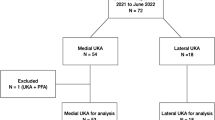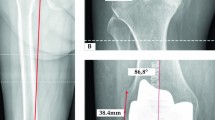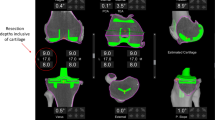Abstract
Purpose
Strategies to further improve patient satisfaction after total knee arthroplasty include the introduction of new alignment philosophies and more precise instruments such as navigation and robotics. The aim of this study was to investigate the effect of a combination of image-based robotic assistance and the use of modern alignment strategies on the resulting joint line obliquity as well as femoral component rotation and to compare this between varus, neutral and valgus knees.
Methods
This retrospective study included 200 patients who received a robotic-assisted total knee arthroplasty (MAKO®, Stryker) using functional alignment between 2018 and 2020. The patients were divided into a varus (103 patients), neutral (57 patients) and valgus (40 patients) group. The intraoperatively recorded bone cuts and resulting joint line obliquity were identified and compared to values obtained with a robotic computer simulation of kinematic alignment.
Results
The mean femoral coronal alignment of the varus, neutral and valgus group, respectively, equalled 0.5° (± 1.1°), 1.1° (± 0.8°) and 1.6° (± 0.7°) of valgus with functional alignment and 2.1° (± 2.1°), 4.1° (± 1.7°) and 6.2° (± 1.7°) of valgus with kinematic alignment. The mean femoral axial alignment of the valgus group resulted in 0.8° (± 2.0°) of internal rotation with functional alignment and 3.9° (± 2.8°) of internal rotation with kinematic alignment. Overall, 186 knees (93%) could be balanced while respecting certain safe zones by using functional alignment as opposed to 54 knees (27% and none in the valgus group) when applying kinematic alignment. Kinematic alignment led to a combination of femoral component valgus and internal rotation of more than 3° in 22 valgus knees (55%), 10 neutral knees (18%) and 3 varus knees (3%) compared to none in each group when applying functional alignment with safe zones.
Conclusions
Robotic-assisted kinematic alignment leads to a combination of excessive valgus and internal rotation of the femoral component in valgus and to a lesser extent also in neutral knees when compared with functional alignment.
Level of evidence
IV.






Similar content being viewed by others
References
Agarwal N, To K, McDonnell S, Khan W (2020) Clinical and radiological outcomes in robotic-assisted total knee arthroplasty: a systematic review and meta-analysis. J Arthroplasty 35:3393–3409
Almaawi AM, Hutt JRB, Masse V, Lavigne M, Vendittoli PA (2017) The impact of mechanical and restricted kinematic alignment on knee anatomy in total knee arthroplasty. J Arthroplasty 32:2133–2140
Arshi A, Sekimura T, Kelley BV, Zeegen EN, Lonner JH, Stavrakis AI (2022) Navigated and robot-assisted technology in total knee arthroplasty: do outcome differences achieve minimal clinically important difference? J Arthroplasty 37:1562–1569
Assiotis A, To K, Morgan-Jones R, Pengas IP, Khan W (2019) Patellar complications following total knee arthroplasty: a review of the current literature. Eur J Orthop Surg Traumatol 29:1605–1615
Batailler C, Fernandez A, Swan J, Servien E, Haddad FS, Catani F et al (2021) MAKO CT-based robotic arm-assisted system is a reliable procedure for total knee arthroplasty: a systematic review. Knee Surg Sports Traumatol Arthrosc 29:3585–3598
Bourne RB, Chesworth BM, Davis AM, Mahomed NN, Charron KD (2010) Patient satisfaction after total knee arthroplasty: who is satisfied and who is not? Clin Orthop Relat Res 468:57–63
Brar AS, Howell SM, Hull ML, Mahfouz MR (2016) Does kinematic alignment and flexion of a femoral component designed for mechanical alignment reduce the proximal and lateral reach of the trochlea? J Arthroplasty 31:1808–1813
Chang JS, Kayani B, Wallace C, Haddad FS (2021) Functional alignment achieves soft-tissue balance in total knee arthroplasty as measured with quantitative sensor-guided technology. Bone Jt J 103-B:507–514
Courtney PM, Lee GC (2017) Early outcomes of kinematic alignment in primary total knee arthroplasty: a meta-analysis of the literature. J Arthroplasty 32:2028–2032
Eisenhuth SA, Saleh KJ, Cui Q, Clark CR, Brown TE (2006) Patellofemoral instability after total knee arthroplasty. Clin Orthop Relat Res 446:149–160
Font-Rodriguez DE, Scuderi GR, Insall JN (1997) Survivorship of cemented total knee arthroplasty. Clin Orthop Relat Res 345:79–86
Hetaimish BM, Khan MM, Simunovic N, Al-Harbi HH, Bhandari M, Zalzal PK (2012) Meta-analysis of navigation vs conventional total knee arthroplasty. J Arthroplasty 27:1177–1182
Heyse TJ, El-Zayat BF, De Corte R, Chevalier Y, Fuchs-Winkelmann S, Labey L (2018) Internal femoral component malrotation in TKA significantly alters tibiofemoral kinematics. Knee Surg Sports Traumatol Arthrosc 26:1767–1775
Howell SM, Howell SJ, Kuznik KT, Cohen J, Hull ML (2013) Does a kinematically aligned total knee arthroplasty restore function without failure regardless of alignment category? Clin Orthop Relat Res 471:1000–1007
Howell SM, Papadopoulos S, Kuznik K, Ghaly LR, Hull ML (2015) Does varus alignment adversely affect implant survival and function six years after kinematically aligned total knee arthroplasty? Int Orthop 39:2117–2124
Keshmiri A, Maderbacher G, Baier C, Benditz A, Grifka J, Greimel F (2019) Kinematic alignment in total knee arthroplasty leads to a better restoration of patellar kinematics compared to mechanic alignment. Knee Surg Sports Traumatol Arthrosc 27:1529–1534
Kim YH, Yoon SH, Park JW (2020) Does robotic-assisted TKA result in better outcome scores or long-term survivorship than conventional TKA? A randomized, controlled trial. Clin Orthop Relat Res 478:266–275
Klasan A, de Steiger R, Holland S, Hatton A, Vertullo CJ, Young SW (2020) Similar risk of revision after kinematically aligned, patient-specific instrumented total knee arthroplasty, and all other total knee arthroplasty: combined results from the Australian and New Zealand joint replacement registries. J Arthroplasty 35:2872–2877
Klasan A, Kapshammer A, Miron V, Major Z (2022) Kinematic alignment in total knee arthroplasty reduces polyethylene contact pressure by increasing the contact area, when compared to mechanical alignment-a finite element analysis. J Pers Med 12:1285
Koh DTS, Woo YL, Yew AKS, Yeo SJ (2021) Kinematic aligned femoral rotation leads to greater patella tilt but similar clinical outcomes when compared to traditional femoral component rotation in total knee arthroplasty. A propensity score matched study. Knee Surg Sports Traumatol Arthrosc 29:1059–1066
Kort N, Stirling P, Pilot P, Muller JH (2022) Robot-assisted knee arthroplasty improves component positioning and alignment, but results are inconclusive on whether it improves clinical scores or reduces complications and revisions: a systematic overview of meta-analyses. Knee Surg Sports Traumatol Arthrosc 30:2639–2653
Lee YS, Howell SM, Won YY, Lee OS, Lee SH, Vahedi H et al (2017) Kinematic alignment is a possible alternative to mechanical alignment in total knee arthroplasty. Knee Surg Sports Traumatol Arthrosc 25:3467–3479
Luo Z, Zhou K, Peng L, Shang Q, Pei F, Zhou Z (2020) Correction to: Similar results with kinematic and mechanical alignment applied in total knee arthroplasty. Knee Surg Sports Traumatol Arthrosc 28:1736–1741
MacDessi SJ, Griffiths-Jones W, Harris IA, Bellemans J, Chen DB (2021) Coronal Plane Alignment of the Knee (CPAK) classification. Bone Jt J 103-B:329–337
Nettrour JF, Razu SS, Keeney JA, Guess TM (2019) Femoral component malrotation produces quadriceps weakness and impaired ambulatory function following total knee arthroplasty: results of a forward-dynamic computer model. J Knee Surg. https://doi.org/10.1055/s-0039-1692486
Oussedik S, Abdel MP, Victor J, Pagnano MW, Haddad FS (2020) Alignment in total knee arthroplasty. Bone Jt J 102:276–279
Risitano S, Cacciola G, Sabatini L, Capella M, Bosco F, Giustra F et al (2022) Restricted kinematic alignment in primary total knee arthroplasty: a systematic review of radiographic and clinical data. J Orthop 33:37–43
Shelton TJ, Gill M, Athwal G, Howell SM, Hull ML (2021) Outcomes in patients with a calipered kinematically aligned TKA that already had a contralateral mechanically aligned TKA. J Knee Surg 34:87–93
Winnock de Grave P, Kellens J, Luyckx T, Tampere T, Lacaze F, Claeys K (2022) Inverse kinematic alignment for total knee arthroplasty. Orthop Traumatol Surg Res 108:103305
Acknowledgements
The authors thank Wim Coucke for his contribution to the statistical analysis of this study.
Funding
None.
Author information
Authors and Affiliations
Contributions
The contribution of each author meets the requirements for authorship as defined by the ICMJE guidelines.
Corresponding author
Ethics declarations
Conflict of interest
One of the authors receives consulting fees from Stryker (TL). The other authors certify that there are no funding or commercial associations (consultancies, stock ownership, equity interest, patent/licensing arrangements, etc.) that might pose a conflict of interest in connection with the submitted article related to the author or any immediate family members.
Ethical approval
Ethical approval for this study was obtained from the hospital’s ethics committee (AZ Delta Roeselare).
Informed consent
None was required at it concerns a retrospective, anonymized study.
Additional information
Publisher's Note
Springer Nature remains neutral with regard to jurisdictional claims in published maps and institutional affiliations.
Rights and permissions
Springer Nature or its licensor (e.g. a society or other partner) holds exclusive rights to this article under a publishing agreement with the author(s) or other rightsholder(s); author self-archiving of the accepted manuscript version of this article is solely governed by the terms of such publishing agreement and applicable law.
About this article
Cite this article
Ollivier, B., Vandenneucker, H., Vermue, H. et al. A robotic-assisted simulation of kinematic alignment in TKA leads to excessive valgus and internal rotation in valgus knees. Knee Surg Sports Traumatol Arthrosc 31, 4747–4754 (2023). https://doi.org/10.1007/s00167-023-07504-x
Received:
Accepted:
Published:
Issue Date:
DOI: https://doi.org/10.1007/s00167-023-07504-x




